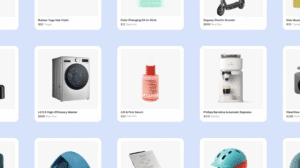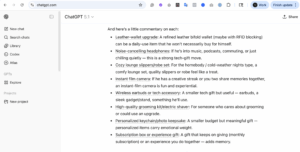OpenAI Launches Shopping Research in ChatGPT: What it Means for Brands

On November 24, OpenAI released shopping research, a new feature in ChatGPT that acts as a shopping assistant. It’s currently available on web and mobile for users with GPT-5 access.
What It Does
Shopping research is designed to streamline product discovery. Instead of checking multiple retailer sites and review pages, you explain what you need and ChatGPT handles the research. It asks a few clarifying questions to understand your budget, priorities, and how you plan to use the product, then pulls real-time information from reliable retail and editorial sites. Rather than giving you a long list of links, it narrows everything down to a short set of options that match what you described, along with a clear explanation of why each one fits.


How Does OpenAI’s Shopping Research Work?
According to OpenAI, shopping research is powered by a specialized version of GPT-5 mini that is trained to understand how people look for products and what factors influence a buying decision. When you share your criteria, the model uses those inputs to determine which product pages, reviews, and specifications to pull from across the web. It evaluates details such as pricing, features, availability, and the meaningful differences between items. The final output includes the top options, an explanation of why they fit your needs, pros and cons of each product, and links to the sites where the information was found.
Why It Matters
LLMs have already started influencing early product research, with many shoppers turning to ChatGPT or Gemini before (or instead of) traditional search engines. People use these tools to narrow their options, understand which features matter, and compare products at a high level. Shopping research takes that further by pushing ChatGPT into the consideration phase. It now influences which products shoppers consider worth looking at.
For brands, that raises two questions:
- Is your product information available and accurate in the places ChatGPT pulls from?
- Is your brand strong enough online for ChatGPT to surface it as a top option when the query fits?
As shopping research becomes more common, brands with clean product data and strong third-party coverage will be better positioned to appear in these moments of intent.
What Brands Should Do Now
ChatGPT pulls from the open web, so it’s essential to make sure your product info is structured, readable, and credible.
1. Keep Product Listings Optimized and Up to Date
ChatGPT uses the information users provide in their searches to understand what they are looking for and match those inputs to product data across the internet. This makes accurate, well-structured product listings even more important. Keeping product details, pricing, specs, and availability up to date across your PDPs and feeds helps ChatGPT understand when your products match what a user is looking for.
It’s important to note that shopping research doesn’t rely on keyword targeting the way Google Shopping or Amazon Search do. Instead, it analyzes a user’s entire prompt and uses that information to decide what to search and which products are most relevant.
2. Use Schema Markup Strategically
Structured data helps LLMs read and interpret product information accurately, which matters now that ChatGPT is pulling details directly from the open web. Clean, consistent schema makes it easier for shopping research to understand what your product offers and when it’s relevant to a user’s request. Make sure to:
- Use the latest versions of Product, Offer, and Review schema
- Tag key attributes like price, ratings, availability, features, and shipping
- Validate your schema regularly so data stays accurate across feeds and PDPs
3. Build Credibility Through Third-Party Coverage
Shopping research pulls from a range of external sources to understand which products people find useful and credible. Because it reads a lot of affiliate content, publisher roundups, and reviews, having a strong presence in these places can help your products surface more often. Focus on:
- Verified reviews on your own site and major marketplaces
- Publisher coverage such as articles, listicles, gift guides, and affiliate roundups
When your product appears consistently across trusted publishers, and those articles include detailed product information, ChatGPT can more accurately understand what it offers and when it fits a user’s request.
Ready to strengthen your presence on trusted publisher sites? WITHIN’s Affiliate team can help.
4. Track ChatGPT Traffic
As shopping research becomes a bigger part of product discovery, it’s important to understand how users from ChatGPT are interacting with your site. Look at referrer patterns, click-through paths, and source IDs to identify traffic coming from ChatGPT. This will give you a clearer view of its impact on attribution and understanding its role within your funnel.
What’s Coming Next
Right now, ChatGPT sends users to retailers or third-party sites to complete a purchase. But OpenAI has already stated that the next step is instant checkout, which would allow users to buy products directly within the chat experience.
Are you prepared for the future of search? WITHIN’s SEO team can help you navigate the shifting search landscape and make sure your products show up where shoppers start their search.
Let’s Chat
Author
Christina Hatzipanagiotis, SEO Account Manager